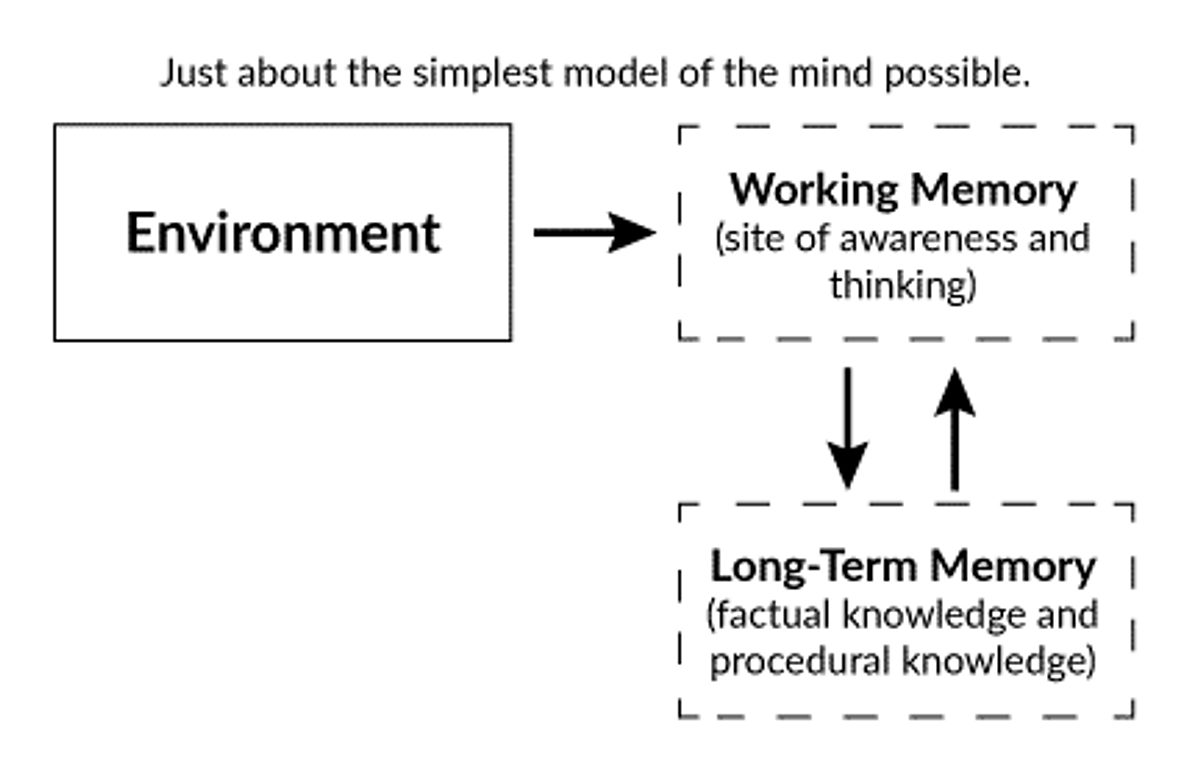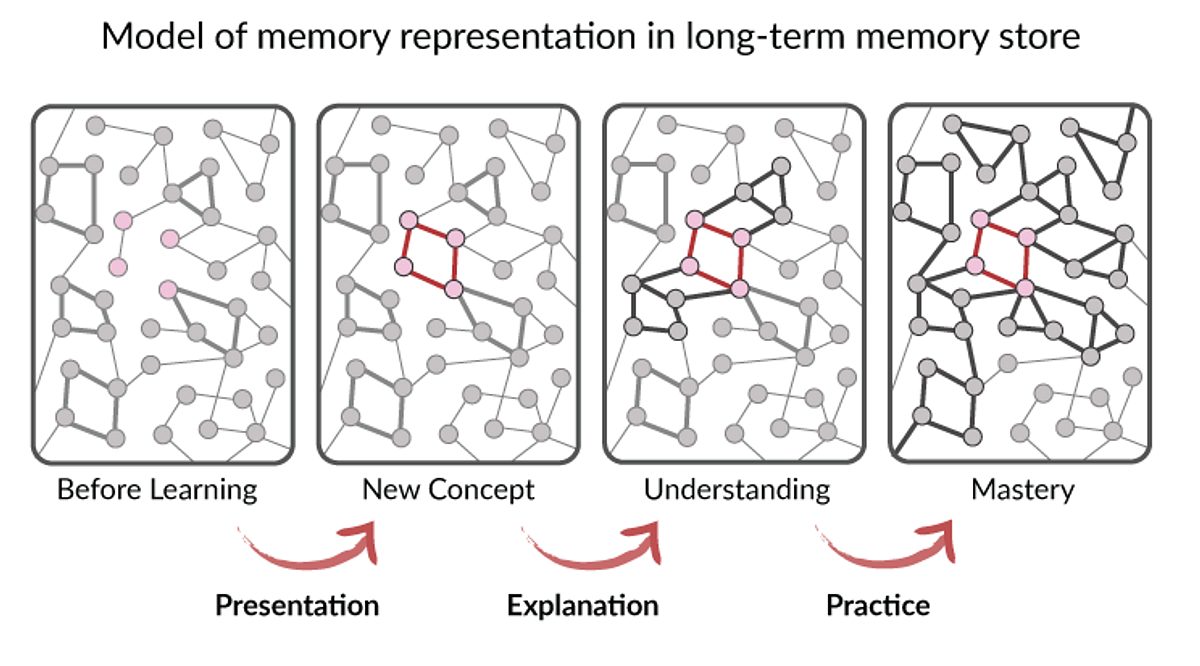Improving Secondary Science – FULLY BOOKED
A two-day training programme to explore the most effective ways to improve teaching and results

Sandringham Research School is no longer active. We are continuing to support schools in the region through the wider Research School Network.
Search for other Research Schools in your area
Share on:

by Sandringham Research School
on the
by Elizabeth Mountstevens, Evidence Lead
Strand 4 of the EEF Secondary Science report highlights the importance of an understanding of memory to support students to retain and retrieve knowledge. I have found a basic understanding of some of the models of the mind derived from cognitive science and neuroscience have helped to develop curricula that support students to retain and retrieve knowledge; this blog discusses two of the most useful.
The model in Figure 1 is taken from a blog by the cognitive scientist Daniel Willingham (2009). He describes the mind as consisting of two parts, working memory and long-term memory. Information enters working memory from both our environment and long-term memory, the later in the form of prior knowledge. Working memory is the site of our conscious thinking and where information is processed before being encoded into long term memory.

The most useful thing to know about working memory is that it is very small in size. Original estimates were that it could hold about seven items, but more recent work has suggested that this number could be as low as four. This makes it very hard to think about tasks which contain a larger number of different components, such as multi-step calculations, and can lead to incomplete recall, failure to follow instructions, place-keeping errors and ultimately task abandonment (Gathercole and Alloway 2007).
Fortunately, there are some ways to manage the limitations of working memory. The first is to ensure the presence of relevant prior knowledge. Compare how much harder it is to memorise a string of random letters, such as DOQ FCA ERP AMB HGR, than it is to remember those where we have some prior knowledge, such as DFE OCR AQA MPH GBR. In the latter example, our prior knowledge means that rather than 15 individual items to hold in our working memory we now have five, a much more manageable number.
This shows how important sequencing is in curriculum design. Without prior knowledge related to a new concept, students will rapidly find their working memory overwhelmed. It is important that sequencing is checked, not only within scientific disciplines, but also between them. In a recent review of our KS3 curriculum we discovered that diffusion was being taught in the Cells topic at the start of year 7 as the movement of particles from an area of low concentration to an area of high concentration, but that concentration itself wasn’t covered until the Acids topic later in the year.
However, we need to do better than just ensure content is taught in the best sequence. Prior knowledge will only help overcome the limitations of working memory if it is securely understood. In a busy curriculum it may be necessary to prioritise the content which will have the greatest benefit to future understanding. Compare the following statements from the OCR Twenty First Century Science Chemistry specification: ‘explain ionic bonding in terms of electrostatic forces and transfer of electrons’ and ‘recall that crude oil is a main source of hydrocarbons and is a feedstock for the petrochemical industry’. The knowledge of ions required by the first statement is critical in understanding the later concepts of oxidation and reduction, electrolysis, corrosion, acids and neutralisation. In contrast, the statement about crude oil, although interesting, is much less critical in understanding what follows. In our recent review of KS3 Science we identified the key knowledge that was critical for future understanding to ensure this was covered in greater depth.
The second way we can manage the limitations of working memory is to introduce new ideas in small chunks, practising them extensively, before combining them together. This is well illustrated by the example of mole calculations. For students to answer the question ‘What mass of aluminium can be produced from 400kg of aluminium oxide?’ they must complete the steps in figure 2. Introducing the full method at once overwhelms the students’ working memory. The alternative is to introduce the steps one by one with extensive practice of each step before combining. This begins the process of automating each individual step so that they occupy less space in working memory.

Model 2: ‘The network model’ Efrat Furst (2018)
The second model, described by Efrat Furst in an article for ResearchEd (2018), describes how knowledge is stored in long-term memory. Neurons (nodes) and synapses (connectors) create neuronal representations of learned information. When new information is introduced, and explained, new connections are formed. When this information is later retrieved from long-term memory, useful connections are strengthened, making it easier to retrieve the information in future.

This second model reinforces the importance of prior knowledge and the need to make connections to new content being learned. There is some evidence that making these links clear through concept mapping and comparison can improve pupil learning (EEF 2021). Study techniques like elaboration and self-explanation also show promise in this regard (Dunlosky 2013).
The network model also emphasises the importance of retrieval practice. There are a significant number of studies showing that spacing this practice across days and lessons can have a small positive impact on learning outcomes (EEF 2021); this spaced practice can be achieved through curriculum design. When we were designing our new KS4 Chemistry curriculum in 2016 we highlighted two key areas that we believed were key to progression in Chemistry: bonding and moles. These ideas were introduced early and then revisited regularly in different contexts throughout the course; figure 4 shows how this was done with moles.

In summary, the two models of the mind have the following implications for the design of Science curricula:


Blog -
by Kate Mouncey – Director

Blog -
working with groups of schools

Blog -
5 musings on early reading and writing
This website collects a number of cookies from its users for improving your overall experience of the site.Read more